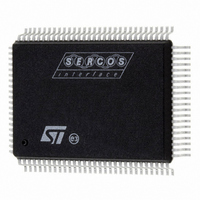ST92F150CV1QB STMicroelectronics, ST92F150CV1QB Datasheet - Page 102

ST92F150CV1QB
Manufacturer Part Number
ST92F150CV1QB
Description
MCU 8BIT 128K FLASH 100PQFP
Manufacturer
STMicroelectronics
Series
ST9r
Datasheet
1.ST92F150CV1TB.pdf
(429 pages)
Specifications of ST92F150CV1QB
Core Processor
ST9
Core Size
8/16-Bit
Speed
24MHz
Connectivity
CAN, I²C, LIN, SCI, SPI
Peripherals
DMA, LVD, POR, PWM, WDT
Number Of I /o
77
Program Memory Size
128KB (128K x 8)
Program Memory Type
FLASH
Eeprom Size
1K x 8
Ram Size
4K x 8
Voltage - Supply (vcc/vdd)
4.5 V ~ 5.5 V
Data Converters
A/D 16x10b
Oscillator Type
Internal
Operating Temperature
-40°C ~ 105°C
Package / Case
100-QFP
Processor Series
ST92F15x
Core
ST9
Data Bus Width
8 bit, 16 bit
Data Ram Size
6 KB
Interface Type
CAN, I2C, SCI, SPI
Maximum Clock Frequency
24 MHz
Number Of Programmable I/os
80
Number Of Timers
5 x 16 bit
Operating Supply Voltage
4.5 V to 5.5 V
Maximum Operating Temperature
+ 105 C
Mounting Style
SMD/SMT
Development Tools By Supplier
ST92F150-EPB
Minimum Operating Temperature
- 40 C
On-chip Adc
16 bit x 10 bit
Lead Free Status / RoHS Status
Lead free / RoHS Compliant
Other names
497-4882
Available stocks
Company
Part Number
Manufacturer
Quantity
Price
Company:
Part Number:
ST92F150CV1QB
Manufacturer:
STMicroelectronics
Quantity:
10 000
- Current page: 102 of 429
- Download datasheet (8Mb)
ST92F124/F150/F250 - INTERRUPTS
5.7 STANDARD INTERRUPTS (CAN AND SCI-A)
The two on-chip CAN peripherals generate 4 inter-
rupt sources each. The SCI-A interrupts are
mapped on a single interrupt channel. The map-
ping is shown in the following table.
Table 21. Interrupt Channel Assignment
5.7.1 Functional Description
The SIPRL and SIPRH registers contain the inter-
rupt pending bits of the interrupt sources. The
pending bits are set by hardware on occurrence of
a rising edge event. The pending bits are reset by
hardware when the interrupt is acknowledged.
The SIMRL and SIMRH registers are used to
mask the interrupt requests coming from the inter-
rupt sources. Resetting the bits of these registers
prevents the interrupt requests being sent to the
ST9 core.
The SITRL and SITRH registers are used to select
the edge sensitivity of the interrupt channel (rising
or falling edge). As the SCI-A and CAN interrupt
events are rising edge events, all bits in the SITRL
register and ITEI0 bit in SITRH register must be
set to 1.
102/429
9
Interrupt Pairs
INTG0
INTG1
INTE1
INTF0
INTF1
INTH0
INTH1
INTE0
INTI0
INTI1
Interrupt Source
CAN0_SCE
CAN1_SCE
CAN0_RX0
CAN0_RX1
CAN1_RX0
CAN1_RX1
CAN0_TX
CAN1_TX
Reserved
SCI-A
The priority level of the interrupt channels can be
programmed to one of eight priority levels using
the SIPLRL and SIPLRH control registers.
The two MSBs of the priority level are user pro-
grammable. For each interrupt group, the even
channels (E0, F0, G0, H0, I0) have an even priority
level (LSB of priority level is zero) and the odd
channels (E1, F1, G1, H1) have an odd priority lev-
el (the LSB of priority level is one). See
.
Figure 52. Priority Level Examples
All interrupt channels share a single interrupt vec-
tor register (SIVR). Bits 1 to 4 of the SIVR register
change according to the interrupt channel which
has the highest priority pending interrupt request.
If more than one interrupt channel has pending in-
terrupt requests with the same priority, then an in-
ternal daisy chain decides the interrupt channel
that will be served. INTE0 is first in the internal dai-
sy chain and INTI0 is last.
An overrun flag is associated with each interrupt
channel. If a new interrupt request comes before
the earlier interrupt request is acknowledged then
the corresponding overrun flag is set.
INT.H1: 001=1
INT.G0:
INT.G1:
SOURCE
INT.H0: 000=0
101=5
100=4
PRIORITY
PL2H PL1H PL2G PL1G PL2F PL1F PL2E PL1E
1
0
0
0
1
0
0
1
SOURCE
INT.E0: 010=2
INT.E1: 011=3
INT.F1: 101=5
INT.F0: 100=4
IPLRL
Figure
PRIORITY
52.
Related parts for ST92F150CV1QB
Image
Part Number
Description
Manufacturer
Datasheet
Request
R

Part Number:
Description:
BOARD PROGRAM FOR ST92F150 MCU
Manufacturer:
STMicroelectronics
Datasheet:

Part Number:
Description:
BOARD EVALUATION FOR ST9 SERIES
Manufacturer:
STMicroelectronics
Datasheet:

Part Number:
Description:
BOARD EMULATOR FOR ST9 SERIES
Manufacturer:
STMicroelectronics
Datasheet:

Part Number:
Description:
MCU, MPU & DSP Development Tools ST9 Dedication Board
Manufacturer:
STMicroelectronics
Datasheet:

Part Number:
Description:
STMicroelectronics [RIPPLE-CARRY BINARY COUNTER/DIVIDERS]
Manufacturer:
STMicroelectronics
Datasheet:

Part Number:
Description:
STMicroelectronics [LIQUID-CRYSTAL DISPLAY DRIVERS]
Manufacturer:
STMicroelectronics
Datasheet:

Part Number:
Description:
BOARD EVAL FOR MEMS SENSORS
Manufacturer:
STMicroelectronics
Datasheet:

Part Number:
Description:
NPN TRANSISTOR POWER MODULE
Manufacturer:
STMicroelectronics
Datasheet:

Part Number:
Description:
TURBOSWITCH ULTRA-FAST HIGH VOLTAGE DIODE
Manufacturer:
STMicroelectronics
Datasheet:

Part Number:
Description:
Manufacturer:
STMicroelectronics
Datasheet:

Part Number:
Description:
DIODE / SCR MODULE
Manufacturer:
STMicroelectronics
Datasheet:

Part Number:
Description:
DIODE / SCR MODULE
Manufacturer:
STMicroelectronics
Datasheet:











